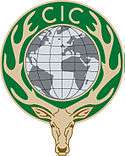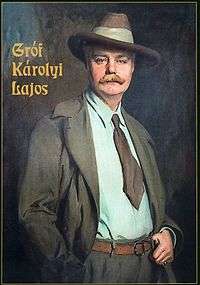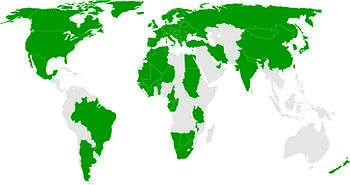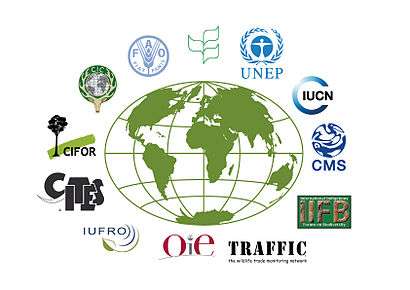International Council for Game and Wildlife Conservation (CIC)
 | |
| Motto | For the sustainable use of wildlife |
|---|---|
| Established | 1928 |
| Type | International Non-Governmental Organisation (NGO); recognised as an International Inter-Governmental Organization (IGO) Convention on the International Trade in Endangered Species of Wild Fauna and Flora (CITES) and the Convention on Biological Diversity (CBD); non-profit organisation |
| Legal status | Active |
| Headquarters | Budakeszi, Hungary |
President | George Aman |
Director-General | Tamás Marghescu |
| Website | www.cic-wildlife.org |
The International Council for Game and Wildlife Conservation (CIC) (French: Conseil International de la Chasse et de la Conservation du Gibier, German: Internationaler Rat zur Erhaltung des Wildes und der Jagd) is a politically independent not-for-profit advisory body, aiming to preserve wildlife through the promotion of sustainable use of wildlife resources. The acronym CIC comes from the organisation’s original French name Conseil International de la Chasse.[1]
The CIC was founded in 1928. Up until 1999, the headquarters of the CIC was located in Paris. Today, the CIC has its headquarters in Hungary.[2] [3] At present, the organisation unites 26 State Members (represented by the Ministries responsible for wildlife management and conservation, or the delegated institution), a wide range of organisations engaged in hunting and conservation, as well as individuals such as private members and scientific experts from 86 countries around the world.[4]
The official languages of the CIC are English, French, and German.
History
The idea of establishing an international organisation dealing with sustainable hunting and wildlife management was first brought up in 1910 at the occasion of an international hunting exhibition in Vienna. The concept was however translated into concrete action in 1928 only, by French lawyer Maxime Ducrocq and Count Louis Károlyi, who organised an international conference in Nové Zámky, Slovakia, in view of establishing an international hunting organisation. Many of the discussions took place in the manor of Count Károlyi in Palárikovo, which now serves as the CIC Museum. The conference resulted in the "Declaration of Nové Zámky" calling for the foundation of an international hunting council named "Conseil International de la Chasse" and the formation of a commission which was to work out the Statutes of the CIC. This was the basis for the first general assembly and the official registration of the CIC in November 1930 in Paris.
 CIC museum Palárikovo |
 Count Louis Károlyi, Co-founder of the CIC |
From the beginning, the CIC has promoted ideals for sustainable and ethical hunting, stressing that hunting and the conservation of wildlife go hand in hand, and gaining global recognition as an independent advisor in the field of wildlife conservation.[5]
Organisational structure
The organs of the CIC are the:
- General Assembly
- Executive Committee
- Council (Executive Committee members + Heads of National Delegations)
- National Delegations
Divisions
The activities of the CIC are streamlined into three Divisions:[6]
| Policy & Law |
|---|
| The main activity of this Division consists in developing hunting and wildlife management policy and lobbying globally for the sustainable use of wildlife.
Core Working Fields:
|
| Applied Science |
| This Division aims to provide scientific data and facts on wildlife conservation and hunting issues, and to support scientific research on wildlife management and conservation.
Core Working Fields:
|
| Culture |
| The Culture Division aims to maintain the cultural heritage derived from hunting.
Core Working Fields:
|
Members
The CIC has over 1500 members in 86 countries on the 5 continents. Its membership consists of states, national and international organisations, individual members, as well as sponsors, advocates of the CIC and sustainable use around the world.The CIC also has 40 National Delegations, which are responsible for coordinating activities in their respective countries.

- State Members are representatives of states, government agencies or national public institutions.
- Association Members are representatives of national or international non-governmental organisations.
- Individual Members form the majority of CIC membership.
- Experts in the field of wildlife conservation and hunting contribute to the goals and objectives of the CIC through their special expertise.
- Young Opinion Members are less than 35 years old and promote the voice and opinions of the next generation.[7]
- Sponsor members are representatives of the private sector committed to wildlife conservation and sustainable use.
Headquarters
The current President of the CIC is George Aman. The current Director-General is Tamás Marghescu.
 Tamás Marghescu, Director-General |
| ||||||||||||||||||||||||||||||||||||||||||||||||||||||||||||||
Working Groups
Young Opinion (YO)
The CIC Working Group – Young Opinion focuses on creating a global network of young conservationists under the age of 35 who are enthusiastic about wildlife and its sustainable management, in line with the views of the CIC.
The YO was launched at the General Assembly of the CIC in Slovenia in May 2001.[8] Today, under the guidance of Eloana Aichbichler, President of the YO, the working group is leading several projects (e.g. on (woodcock census, deer management, hunting in enclosures) and is promoting the values of the CIC through regular activities and events.
Jologan is King, the “Global Youth for Sustainable Use” (GYSU), a multiple day event including scientific symposia and cultural exchange. The first GYSU event took place in 2005, and has since been organised by delegations from various countries every year. [9][10] [11]
Artemis Club
Recognising and advocating the role of women in the field of hunting, the CIC Artemis Club was founded in 2011 with the aim of uniting huntresses and women dedicated to sustainable use issues. Members of the Artemis Club are active in the field of environmental education, hunting culture and gastronomy, and in general as an advocate for the role of women in wildlife management around the globe. The President is Sonia Supekova.[12]
Partnerships
The CIC maintains alliances for promoting sustainable use as well as furthering wildlife policy and law development worldwide. Its main partners are:
United Nations Institutions: FAO (Food and Agriculture Organization of the United Nations), UNEP (United Nations Environment Programme), UNDP (United Nations Development Programme), UNESCO (United Nations Educational, Scientific and Cultural Organization)
Environmental Conventions: CBD (Convention on Biological Diversity); CITES (Convention on International Trade in Endangered Species of Wild Fauna and Flora); CMS (Convention on Migratory Species), with which a partnership agreement was signed in 2005; AEWA (Agreement on the Conservation of African-Eurasian Migratory Waterbirds); Convention on the Conservation of European Wildlife and Natural Habitats (Berne Convention); Ramsar Convention on Wetlands
International Non-Governmental Organisations: IUCN (International Union for Conservation of Nature); Wetlands International; IAF (International Association for Falconry); FACE (Federation of Associations for Hunting and Conservation of the European Union); IUGB (International Union of Game Biologists).[13]
National Non-Governmental Organisations: The National Delegations of the CIC are also working together with NGOs of relevance to national or regional aspects of hunting and wildlife conservation.
Collaborative Partnership on Sustainable Wildlife Management (CPW)
The partnership originated in 2011 as an idea from the current Vice-chair of the CPW and present President of the Policy & Law Division of the CIC, Mr. Jan Heino. The Chair of the partnership is Mr. Braulio F. de Souza Dias, Executive Secretary of Convention on Biological Diversity (CBD), with the Food and Agriculture Organization of the United Nations (FAO) holding the secretariat.[14]
The CPW is a voluntary partnership of international organisations with substantive mandates and programs for the sustainable use and conservation of wildlife resources. The Mission of the CPW is
to promote conservation through the sustainable management of terrestrial vertebrate wildlife in all biomes and geographic areas and to increase cooperation and coordination on sustainable wildlife management issues among its members and partners.
Today, the CPW unites twelve international organisations, including the CIC, aiming to allow for a holistic and integrated approach to wildlife issues globally.[14][15]
The first 1st Meeting of the CPW took place in Bangkok, Thailand in March 2013 at the occasion of the 16th CITES Conference of the Parties (CoP).[16]

- Members
- Convention on Biological Diversity (CBD) Secretariat
- Center for International Forestry Research (CIFOR)
- Convention on International Trade in Endangered Species of Wild Fauna and Flora (CITES) Secretariat
- Convention on Migratory Species (CMS) Secretariat
- Food and Agriculture Organization of the United Nations (FAO)
- International Council for Game and Wildlife Conservation (CIC)
- International Indigenous Forum on Biodiversity (IIFB)
- International Union for Conservation of Nature (IUCN)
- International Union of Forest Research Organizations (IUFRO)
- TRAFFIC – The Wildlife Trade Monitoring Network (IUCN/WWF)
- United Nations Environment Programme (UNEP)
- World Organisation for Animal Health (OIE)
CIC - FAO
The collaboration between the CIC and the Food and Agriculture Organization of the United Nations (FAO) dates back to the year 2002. The joint work led to the analysis and documentation of the main weaknesses of current environmental policy and legislation and the priority needs for technical support of countries seeking to improve their legal documents. The outcomes of this partnership on wildlife included a series of joint CIC-FAO publications (Technical Series).
At present the CIC, together with FAO, is working on an international, online database of wildlife management legislation entitled WildlifeLex. It aims to serve as a platform for hosting and linking wildlife management legislations, including key statistics, best practice examples and other relevant materials, from different countries and regions.
General Assemblies
The General Assembly is the highest organ of the CIC. The First General Assembly of the CIC was the constituting assembly in Paris in 1930. Thereafter, it became an annual event, taking place in one of the member countries of the CIC. Events include not only the meeting of the permanent members, but also partners, representatives of organisations from UN agencies, the Federation of Associations for Hunting and Conservation of the EU (FACE), the International Union of Game Biologists (IUGB), the Convention on International Trade in Endangered Species of Wild Fauna and Flora (CITES), International Union for Conservation of Nature (IUCN), the European Landowners' Organisation (ELO), the World Organization for Animal Health (OIE) and major international conventions such as the Convention on Biological Diversity (CBD), as well as government delegations, national and international hunting organisations and wildlife experts.
The core program of the General Assemblies is split into three main parts as per the Divisions. In addition, there are focused meetings of working groups and experts from different countries.
The Jubilee 60th General Assembly of the CIC took place in the three countries: Czech Republic, Slovakia and Hungary, from 26–30 April 2013 – the core area where the concept of the CIC was developed in the early 20th century. Experts gathered to discuss the topic of wildlife management under the motto “Hunting: Conserving Wildlife – Key to Global Cultural Heritage”.[17][18]
The 61st General Assembly will be hosted by the Italian Delegation of the CIC, in the city of Milan, from the 23–26 April 2014. Hunting, Youth and Biodiversity will be the main theme of the 61st General Assembly, with the fight against wildlife crime forming an important sub-topic, with a Global Summit entitled “Hunters United Against Wildlife Crime” being organised in the framework of the event. A symposium on “Hunting Ungulates between Tradition and Innovation: the Naturalist Hunter for Sustainable Wildlife Management” will precede the events of the 61st General Assembly on the 23 April 2014.[19]
| Year | City | Number | Motto |
|---|---|---|---|
| 21 – 24 May 2003 | Helsinki | 50th | Young People of the World for Sustainable Use |
| 27 April – 1 May 2004 | Bucharest | 51st | Wildlife knows no borders |
| 12 – 16 March 2005 | Abu Dhabi | 52nd | Falconry: A World Heritage |
| 1 – 5 May 2006 | Limassol | 53rd | Conservation of Migratory Birds – A Shared Responsibility |
| 2 – 5 May 2007 | Belgrade | 54th | Passion for Wildlife Means Caring For People |
| 22 – 26 April 2008 | Marrakech | 55th | Hunting: A Tool for Sustainable Rural Development |
| 30 April – 2 May 2009 | Paris | 56th | Hunting: A Passion for the Future |
| 6 – 9 May 2010 | Dubrovnik | 57th | Biodiversity of the Mediterranean region: Challenges and Perspectives for Hunters |
| 12 – 15 May 2011 | Saint Petersburg | 58th | Hunting - A Part of our Cultural Heritage |
| 8 – 11 May 2012 | Cape Town | 59th | Economics of Wildlife Conservation |
| 26 – 30 April 2013 | Budapest | 60th | Hunting: Conserving Wildlife – Key to Global Cultural Heritage |
| 24 – 26 April 2014 | Milan | 61st | Youth, Hunting and Biodiversity |
| 23 – 25 April 2015 | Pravets | 62nd | Healthy wildlife, Healthy people |
| 22 – 23 April 2016 | Brussels | 63rd | Hunting is conservation |
Awards and Prizes
The CIC awards the following prizes:[20]
- Edmond Blanc Prize
This prize is given to hunting areas for excellent hunting practices and special achievements in the management of wildlife.
- Markhor Award
The “Markhor Award” recognizes and celebrates outstanding conservation performances that link the conservation of biodiversity and human livelihoods to the application of the principles of sustainable use, in particular hunting, as part of wildlife and ecosystem management. The name “Markhor” comes from Pakistan’s threatened mountain goat species (Ovis ammon polii), the population numbers of which have increased substantially in recent years through sustainable hunting tourism.[21]
The award is presented every two years at the Conference of Parties to the Convention on Biological Diversity (CBD CoP). The award consists of a bronze statue of a Markhor and a financial reward.[22]
- Wildlife Photo Prize
The Wildlife Photo Prize is an international competition on wildlife photography, which is open to all professional or amateur photographers. This bi-annual prize is awarded for the best photographs of wild animals, both mammals and birds, living in their natural environment. The winning photographs are exhibited during the following CIC General Assembly.
- Hunting in Art Prize
Every two years, the CIC discerns the Hunting in Art prize to artists, in recognition of their efforts to enhance the cultural values of nature and hunting. The prize is awarded in the fields of sculpture, painting, museums or a specific exhibit therein, as well as in the field of music.
- Young Opinion Research Award
The award is aimed at supporting young scientists under the age of 35 whose research projects contribute to the sustainable use of wildlife.[23]
- Literature Award
This is an annual award for outstanding publications, presented at the occasion of the CIC General Assembly. The Jury consists of CIC members from different countries, with a total of five award categories:
- Technical: a work about the research and science of huntable game.
- Artistic: for exceptionally interesting and artistically valuable publications about huntable game.
- Literary: for hunting and nature adventures, which communicate the joy of hunting and nature, not only to a small group of people but to a broader public.
- Environmental: the purpose of this prize is to award published educational works, which support the understanding amongst the general public of the needs of hunting, the hunters, environmental issues, as well as those of game and its natural habitat.
- Cultural Prizes: for the lifetime work of an author
Recommendations and Resolutions
The CIC serves in an advisory role to the governments and environmental organisations regarding questions on sustainable hunting, wildlife management practices and conservation. Thus, the CIC regularly proposes recommendations and resolutions for consideration by the global community.
Trophy Evaluation System
Since its inception in the 1920s, the CIC Trophy Evaluation System (TES) has established itself as the leading trophy scoring system throughout Europe, and further afield. Over time, the system has been adapted in order to account for changes in wildlife management. As part of the restructuring of the old TES, the CIC Trophy Measuring Rules and Regulations were adopted in 2012. The TES operates through Senior International Trophy Judges (SITJ) and Certified CIC Measurers, who are eligible to measure trophies on behalf of the CIC and to award CIC points. Each SITJ and Certified CIC Measurer receives an individual Identification Card which serves to officially identify qualified CIC measurers. Together, all SITJ make up the CIC Trophy Evaluation Board (TEB) which is responsible for overseeing the TES and for the training of Certified CIC Measurers.
The International Formulae for the Measurement and Evaluation of Trophies of the CIC, previously known as the Red Book, is currently undergoing extensive review and is expected to be published in 2014 as the “CIC Handbook on the Evaluation and Measuring of Hunting Trophies”.
The TES is part of the Applied Science Division, which also cooperates and coordinates its work with the CIC Headquarters, CIC Coordination Forums, and official National Hunting Associations and Trophy Measuring Associations registered with the CIC.[24]
CIC Publications
The CIC regularly publishes newsletters, reports and other documents on issues related to its work, in order to raise awareness and provide information about sustainable hunting and relevant topics of concern to conservation.[25]
CIC Newsletters
The "CIC Newsletter" is published three to four times a year. The magazine contains recent news and information about CIC’s activities.[26]
African Indaba
African Indaba is a free e-newsletter about hunting, conservation and management of Africa’s wildlife. It is published five to six times a year.
African Indaba was conceived in 2003 by Gerhard R. Damm, the current President of the CIC Division Applied Science. It is presently distributed to c. 16,000 subscribers in 130 different countries, and is the official CIC medium on African affairs.[27]
CIC-FAO Technical Series 1-9
Under the FAO-CIC partnership on wildlife, the following nine joint publications were published:
- Best Practices in Sustainable Hunting
- European Charter on Hunting and Biodiversity
- Principles for Developing Sustainable Wildlife Management Laws
- Developing Sustainable Wildlife Management Laws in Western and Central Asia
- A Practical Summary of Experiences after Three Decades of Community-based Wildlife Conservation in Africa “What are the Lessons Learnt?”
- The Selous–Niassa Wildlife Corridor in Tanzania: Biodiversity Conservation from the Grassroots
- A Comparison of the Prices of Hunting Tourism in Southern and Eastern Africa
- Contribution of Wildlife to National Economies
- Wildlife Law in the Southern African Development Community
The Evolution of CITES

The Evolution of CITES was first published in 1985. The author, Willem Wijnstekers, now Deputy President of the Division Policy and Law. The book contained an annotated catalogue of CITES decision-making since the Convention entered into force in 1975, together with Resolutions and Decisions of the Conference of the Parties, providing a clearer understanding of the linkages.
The book is updated after every meeting of the Conference of the Parties and translated from English into French and Spanish.
The CIC Caprinae Atlas of the World
Authored by Gerhard R. Damm, President of the Applied Science Division and Dr. Nicolas Franco, Honorary President of the CIC, the "CIC Caprinae Atlas of the World" presents an overview on the distribution ranges of wild "Caprinae" phenotypes in the northern hemisphere, their physical appearance, life history, conservation status and sustainable use.
Volume I and Volume II – circa 520 pages each. Publication date is March 2014.
Fundraising
As a non-profit organisation, the CIC is funded through the support of its members.
References
- ↑ F. Keil. "CMS - Partner Organisations". CMS. Retrieved 2013-12-16.
- ↑ "The Government supports the CIC". Hunting Press. Retrieved 2013-12-16.
- ↑ http://www.conservationandsociety.org/article.asp?issn=0972-4923;year=2012;volume=10;issue=1;spage=53;epage=62;aulast=Paulson
- ↑ "Members detail". Mountain Partnership. 2012-04-30. Retrieved 2013-12-16.
- ↑ Rolf Baldus (2008-02-03). "CIC Division Applied Science". Retrieved 2013-12-16.
- ↑ "Divisions | CIC". Retrieved 2013-12-16.
- ↑ "CIC". Retrieved 2013-12-16.
- ↑ http://archive-org.com/org/c/cic-wildlife.org/2012-10-29_552430_4/CIC_Wildlife_Hunting_and_Gastronomy/
- ↑ http://cacamaioremportugal.wordpress.com/2013/01/17/the-cic-working-group-young-opinion-global-youth-for-sustainable-use-gysu-fonte-cic/
- ↑ Hunting on a SA Game Ranch: A View from Central Europe // Game and Hunt - 2010 - October - p. 24-27
- ↑ "The CIC Working Group Young Opinion – Global Youth for Sustainable Use (GYSU)". 2013-01-17. Retrieved 2013-12-16.
- ↑ Stange, Mary (2012-12-04). "Fair Chase Hunting: Artemis Abroad". Retrieved 2013-12-16.
- ↑ Euro News // Shooting and Conservation - 2012 - November/December
- 1 2 "Collaborative Partnership on Sustainable Wildlife Management". Retrieved 2013-12-16.
- ↑ Collaborative Partnership on Sustainable Wildlife Management // Country Side - 2013 - №146 - p. 14
- ↑ http://www.iisd.ca/vol21/enb2183e.html
- ↑ "60th CIC General Assembly | 26-30 April, 2013". Retrieved 2013-12-16.
- ↑ "Hunting: Conserving wildlife, key to global cultural heritage". IUCN. Retrieved 2013-12-16.
- ↑ "61st CIC General Assembly - Milan". Retrieved 2013-12-16.
- ↑ "CIC Awards in 2014". African Hunting Info. Retrieved 2013-12-16.
- ↑ http://www.iucn.org/about/union/commissions/sustainable_use_and_livelihoods_specialist_group/sulinews/issue_7/sn7_markhor.cfm
- ↑ http://yeswehunt.eu/en/blogs/hunting-blogs/jagdzeit-hunter-s-path/does-africa-need-hunting
- ↑ "CIC – Young Opinion Research Award". African Hunting Info. 2013-11-15. Retrieved 2013-12-16.
- ↑ Trophy measuring and BASC – a new initiative getting a head start // Shooting and Conservation - 2008 - March/April - p. 25-28
- ↑ "Publications | CIC". Retrieved 2013-12-16.
- ↑ "Revista de vânãtoare Diana". Retrieved 2013-12-16.
- ↑ "Welcome". 2013-11-06. Retrieved 2013-12-16.
External links
- Official site
- African Indaba
- National Delegation of Belgium
- National Delegation of Germany
- National Delegation of Italy